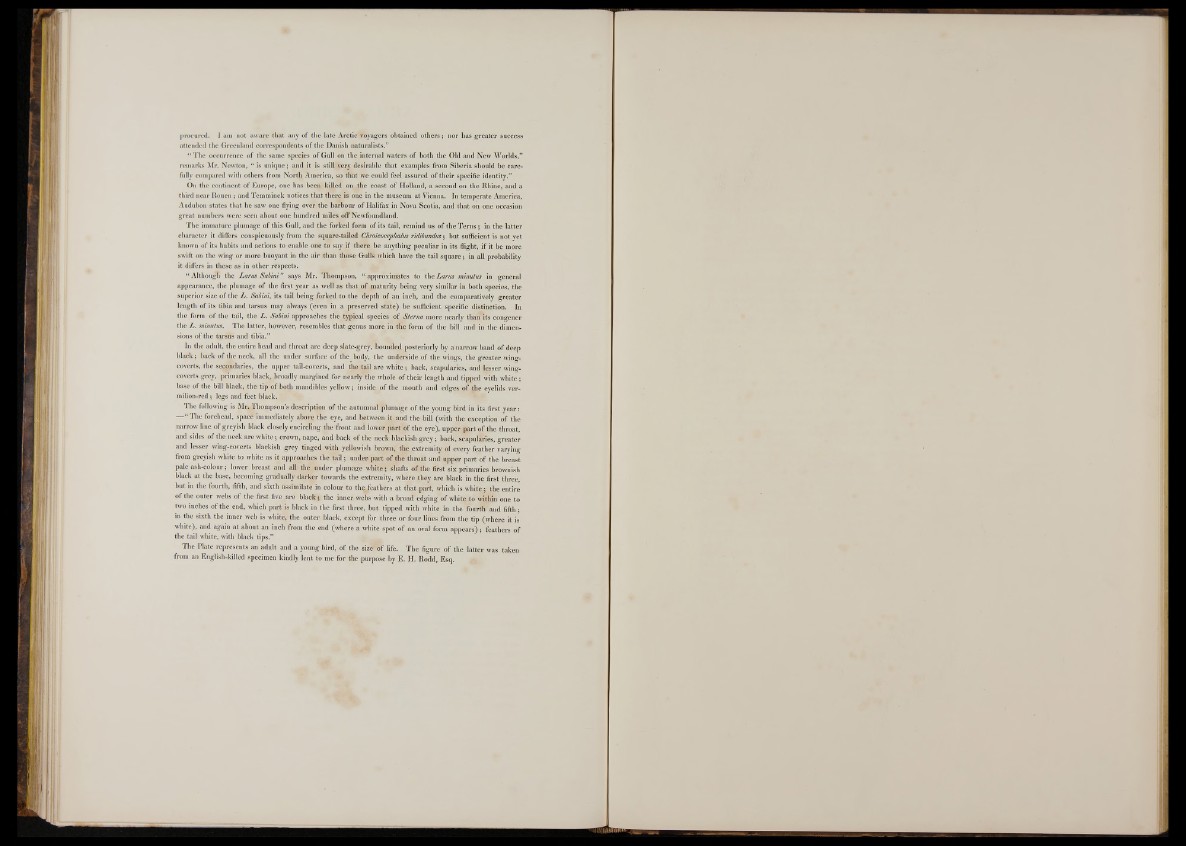
procured. I am not aware that any of the late Arctic Voyagers obtained others; nor has greater success
attended the Greenland correspondents o f the Danish naturalists.”
“ The occurrence o f the same species of Gull on the internal waters o f both the Old and New Worlds,”
remarks Mr. Newton, “ is unique; and it is still very desirable that examples from Siberia should be carefully
compared with others from North America, so that we could feel assured o f their specific identity.”
On the continent of Europe, one has been killed on ¿he coast of Holland, a second on the Rhine, and a
third near R ouen; and Temminck notices that there is one in the museum at Vienna. In temperate America,
Audubon states that he saw one flying over the harbour o f Halifax in Nova Scotia, and that on one occasion
great numbers were seen about one hundred miles off Newfoundland.
The immature plumage of this Gull, and the forked form o f its tail, remind us o f the T erns; in the latter
character it differs conspicuously from the square-tailed Chroicocephalus ridibundus; but sufficient is not yet
known o f its habits and actions to enable one to say if there be anything peculiar in its flight, if it be more
swift on the wing or more buoyant in the air than those Gulls which have the tail square; in all probability
it differs in these as in other respects.
“ Although the Larus Sabini ” says Mr. Thompson, “ approximates to the Larus mi nut us in general
appearance, the plumage of the first year as well as that o f .maturity being very similar in both species, the
superior size o f the L . Sabini, its tail being forked to the depth o f an inch, and the comparatively greater
length o f its tibia and tarsus may always (even in a preserved state) be sufficient specific distinction. In
tbe form of the tail, the L . Sabini approaches the typical species o f Sterna more nearly thari'its congener
the L . minutus. The latter, however, resembles that genus more in the form o f the bill and in the dimem
sions of the tarsus and tibia.”
In the adult, the entire head and throat are deep slate-grey, bounded posteriorly by a narrow band o f deep
black; back of the neck, all the under surface of the body, the underside o f the wings, the greater win«»-,
coverts, the secondaries, the upper tail-coverts, and the tail are white; back, scapularies, and lesser wing-
coverts grey, primaries blacky broadly margined for nearly the whole o f their length and tipped with white;
base of the bill black, the tip of both mandibles yellow; inside o f the mouth and edges pf the eyelids vermilion
red ; legs and feet black.
The following is Mr.^Thompson’s description o f the autumnal plumage o f the young bird in its first year:
—“ The forehead, space immediately above tbe eye, and between jt and the bill (with the exception o f the
narrow line of greyish black closely encircling the front and lower part o f the eye), upper part o f the throat,
and sides of the neck are white; crown, nape, and back o f the neck blackish g rey ; back, scapularies, greater
and lesser wing-coverts blackish grey tinged with yellowish brown, the extremity of every feather varying
from greyish white to white as it approaches the ta il; under part o f the throat and upper part o f the breast
pale ash-colour; lower breast and all the under plumage white; shafts o f the first six primaries brownish
black at the base, becoming gradually darker towards the extremity, where they are black in the first three,
but in the fourth, fifth, and sixth assimilate in colour to th^eathers at that part, which is white; the entire
o f the outer webs o f the first five are black ;, the inner webs with a broad edging o f white to within one to
two inches o f the end, which part is black in the first three, but tipped with white in the fourth and fifth;
in the sixth the inner web is white, the outer black, except for three or four lines from the tip (where it is
white), and again at about an inch from the end (where a white spot o f an oval form appears); feathers of
the tail white, with black tips.” .
The Plate represents an adult and a young bird, of the size^of life. The figure o f the latter was taken
from an English-killed specimen kindly lent to me for the purpose by E. H. Rodd, Esq.